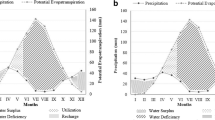Abstract
A study was established in the Virginia Piedmont to investigate theeffects of site preparation treatments (subsoiling and trenching) and the useofweed mats on royal paulownia survival and growth. Seedlings were monitored inthree study blocks for seven years. Following the seventh growing season,survival was low, ranging from 11% in the control plots to 27% in the trenchedplots. Plot volume index averaged 28,633 for the subsoil plots, while controlplots had an average plot volume index of 12,685. Weed mats significantlyincreased soil moisture from 18.7 to 20.4%. Likewise, weed mats significantlyimproved seedling survival after seven years, from 9% to 30%.
Similar content being viewed by others
References
Bergmann B.A. 1998. Propagation method influences first year field survival and growth of Paulownia. New For. 16: 251–264.
Bremner J.M. and Mulvaney C.S. 1982. Nitrogen – total. In: Page A.L., Miller R.H. and Keeney D.R. (eds), Methods of Soil Analysis, Part 2. Agronomy Series No. 9. 2nd edn. Amer. Soc. of Agronomy, Madison, WI, pp. 595–622.
Fleming R.L., Black T.A. and Adams R.S. 1996. Site preparation effects on Douglas-fir and lodgepole pine water relations following planting in a pinegrass-dominated clearcut. For. Ecol. Manage. 83: 47–60.
Graves D.H. and Stringer J.W. 1989. Paulownia–a guide to establishment and cultivation. Univ. of Kentucky Coop. Extension Serv. FOR-39, Lexington, KY, 8 pp.
Haywood J.D. 1999. Durability of selected mulches, their ability to control weeds, and influence growth of loblolly pine seedlings. New For. 18: 263–276.
Hardie I., Kundt J. and Miyasaka E. 1989. Economic feasibility of U.S. paulownia plantations. J. For. 87: 19–24.
Johnson J.E., Burger J.A., Rathfon R.A., Kreh R.E. and Feret P.P. 1991. Foliar nutrient comparisons of pitch pine, loblolly pine, and the pitch x loblolly hybrid. Plant and Soil 132: 1–9.
Johnson J.E., Pease J.W., Johnson L.A. and Hopper G.M. 1992. Tree crops for marginal farmland – royal paulownia, with a financial analysis. Virginia Cooperative Extension Pub. 446–606. Virginia Polytechnic Institute and State University, Blacksburg, VA, 22pp.
Kays J., Johnson D. and Stringer J.W. 1998. How to produce and market paulownia. Univ. of Maryland Coop. Ext. Serv. Bull. 319. College Park, MD, 22pp.
Keeney D.R. 1982. Nitrogen-availability indices. In: Page A.L., Miller R.H. and Keeney D.R. (eds), Methods of Soil Analysis, Part 2. 2nd edn. Amer. Soc. of Agronomy, Madison,WI Agronomy Series No. 9., pp. 722–730.
Kuo S. 1996. Phosphorus. In: Sparks D.L. (ed.), Methods of Soil Analysis, Part 3. Soil Sci. Soc. of Amer., Madison, WI No. 5., pp. 869–919.
Langdon K.R. and Johnson K.D. 1994. Additional notes on invasiveness of Paulownia tomentosa in natural areas. Natural Areas J. 14: 139–140.
McDonald P.M. and Helgerson O.T. 1990. Mulches aid in regenerating California and Oregon forests: Past, present, and future. USDA Forest Serv., Pacific SW Res. Sta., Gen. Tech. Rep, PSW-123.
Preston D.J. 1983. Paulownia-miracle tree or passing fancy? Amer. For. 89: 15–19, 47–52.
Walker R.F. and McLaughlin S.B. 1989. Black polyethylene mulch improves growth of plantation-grown loblolly pine and yellow-poplar. New For. 3: 265–274.
Williams C.E. 1993a. Age structure and importance of naturalized Paulownia tomentosa in a central Virginia streamside forest. Castanea 58: 243–249.
Williams C.E. 1993b. The exotic empress tree, Paulownia tomentosa: An invasive pest of forests? Natural Areas J. 13: 221–222.
Yin R. and He Q. 1997. The spatial and temporal effects of paulownia intercropping-the case of northern China. Agroforestry Systems 37: 91–109.
Zhao-Hua Z., Ching-Ju C., Xin-Yu L. and Yao Gao X. 1997. Paulownia in China: Cultivation and utilization. Asian Network for Biol. Sci. and Intl. Development Res. Ctr., Ottawa, Canada, <http: // www.idrc.ca/library/document /0712351>.
Author information
Authors and Affiliations
Rights and permissions
About this article
Cite this article
Johnson, J.E., Mitchem, D.O. & Kreh, R.E. Establishing royal paulownia on the Virginia Piedmont. New Forests 25, 11–23 (2003). https://doi.org/10.1023/A:1022349231557
Issue Date:
DOI: https://doi.org/10.1023/A:1022349231557




